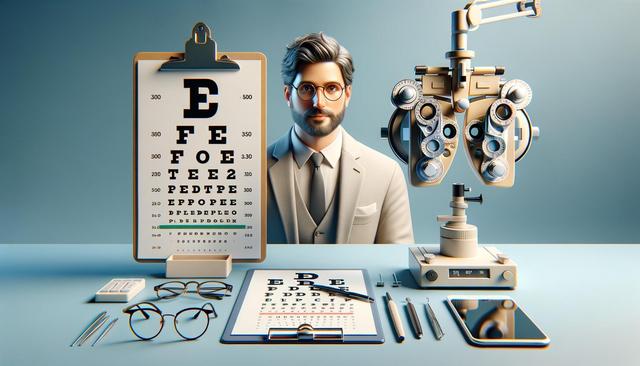What Is an Eye Exam and Why It Matters
An eye exam is a thorough evaluation of your vision and the overall health of your eyes. It goes beyond simply checking how well you can see. A comprehensive eye test can uncover underlying health issues that may not show obvious symptoms, such as glaucoma, cataracts, or even diabetes. During a routine optometry exam, eye care professionals use specialized tools to assess various aspects of your eye health, including eye pressure, peripheral vision, and the condition of the retina.
Many people assume that if they can see clearly, they don’t need a vision checkup. However, some eye conditions develop gradually and without noticeable changes in vision until significant damage has occurred. That’s why regular eye exams are essential, whether or not you wear glasses or contact lenses.
Key components of an eye exam typically include:
- Review of personal and family medical history
- Visual acuity testing with a standard eye chart
- Pupil response and eye muscle movement tests
- Slit-lamp examination for the front part of the eye
- Retinal examination and eye pressure measurement
These checks provide a comprehensive picture of your eye health and can help in early detection of serious conditions.
How Often Should You Schedule a Vision Checkup?
The frequency of eye exams depends on several factors, including age, overall health, and whether you have any vision problems. For adults with healthy eyes and no symptoms, a vision checkup every one to two years is generally recommended. Children should have their first eye test at around six months of age, another at age three, and then just before they start school. After that, regular checkups should continue throughout their school years.
For adults over 60 or people with chronic health conditions such as diabetes or hypertension, more frequent exams may be necessary. These individuals are at a higher risk for conditions like diabetic retinopathy, cataracts, or age-related macular degeneration. Your eye care provider can give you personalized recommendations based on your specific needs.
Regular checkups are particularly crucial if you:
- Experience frequent headaches or eye strain
- Notice changes in your vision such as blurriness or double vision
- Have a family history of glaucoma or other eye diseases
- Use prescription eyewear or contact lenses
Keeping up with your scheduled exams helps maintain good vision and prevents potential complications down the road.
What to Expect During an Optometry Exam
Many people feel unsure about what happens during an optometry exam. Understanding the process can help ease any anxiety and ensure you get the most out of your visit. The exam typically begins with a discussion about your medical history and any vision-related symptoms you may be experiencing. This is followed by a series of tests designed to evaluate your eyesight and check for common eye conditions.
Standard tests include:
- Refraction assessment to determine the correct prescription for glasses or contact lenses
- Visual field test to measure your peripheral vision
- Tonometry to check intraocular pressure, which is important for detecting glaucoma
- Dilation of the pupils to allow a better view of the retina and optic nerve
The entire process usually takes between 30 minutes to an hour, depending on the complexity of the exam. Some tests may be slightly uncomfortable, but none are painful. Bringing a list of current medications and any eyewear you use can help the optometrist assess your needs more accurately.
Eye Care Tips Between Exams
Maintaining good eye health doesn’t stop at the clinic. There are several steps you can take between visits to keep your eyes healthy. Adopting healthy habits can prevent strain and reduce the risk of developing long-term eye conditions. Consistent care is especially important for people who spend extended hours in front of screens or work in environments that can strain the eyes.
Effective daily eye care practices include:
- Following the 20-20-20 rule for screen time: every 20 minutes, look at something 20 feet away for 20 seconds
- Wearing sunglasses that block 100% of UVA and UVB rays when outdoors
- Using protective eyewear in situations where eye injury is a risk
- Maintaining a diet rich in leafy greens, omega-3 fatty acids, and vitamins A, C, and E
- Staying hydrated and getting sufficient sleep
Additionally, avoid rubbing your eyes, which can introduce bacteria and cause irritation. If you wear contact lenses, follow proper hygiene practices including handwashing and using approved cleaning solutions.
Recognizing When You Need an Eye Test
Waiting for noticeable vision problems before scheduling an eye test can lead to delayed treatment of potentially serious conditions. Being proactive about your eye health means recognizing the signs that it’s time to see an eye care professional. Symptoms can sometimes be subtle, but they’re worth paying attention to.
Consider booking an eye test if you notice:
- Persistent eye fatigue or discomfort
- Difficulty seeing at night or reading small print
- Sudden flashes of light or floaters in your vision
- Frequent squinting or tilting your head to see better
- Trouble focusing or adjusting to light changes
These symptoms could be indicators of underlying issues that need prompt attention. Even if you’re not experiencing discomfort, routine exams are a key part of preventive health care. Early detection significantly improves the chances of successful treatment for most eye conditions.
Conclusion: Prioritize Your Eye Health
Taking care of your eyes is an essential part of maintaining your overall well-being. Regular eye exams, combined with daily eye care habits, can help preserve your vision and catch potential issues early. Whether it’s time for your annual vision checkup or you’ve noticed changes in your sight, scheduling an eye test is a proactive step toward better health. By staying informed and attentive to your eye care routine, you give yourself the best chance at maintaining clear, comfortable vision for years to come.




Leave a Reply